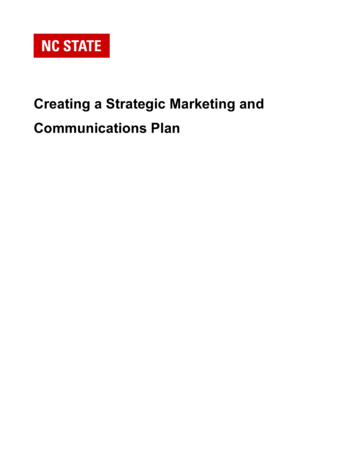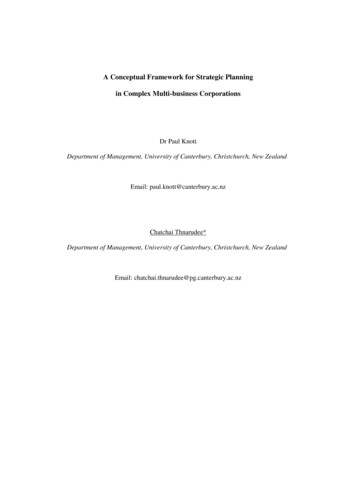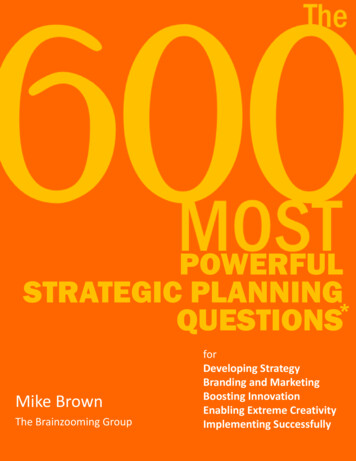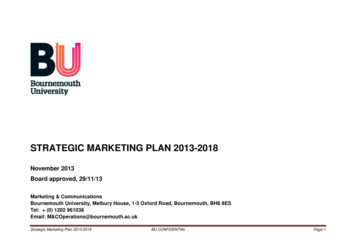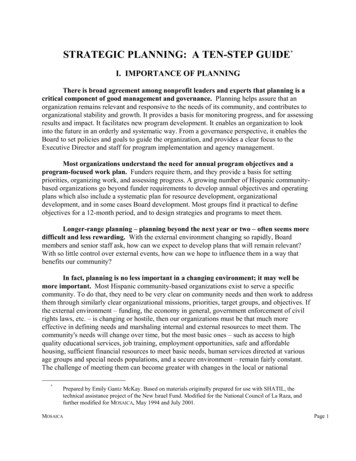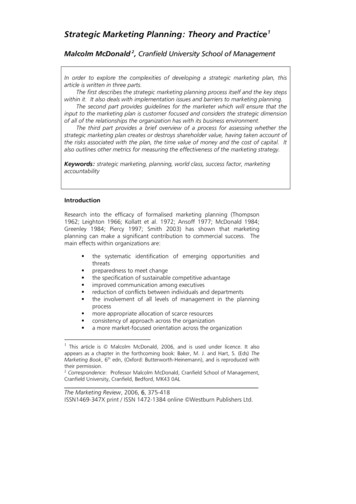
Transcription
Strategic Marketing Planning: Theory and Practice1Malcolm McDonald 2, Cranfield University School of ManagementIn order to explore the complexities of developing a strategic marketing plan, thisarticle is written in three parts.The first describes the strategic marketing planning process itself and the key stepswithin it. It also deals with implementation issues and barriers to marketing planning.The second part provides guidelines for the marketer which will ensure that theinput to the marketing plan is customer focused and considers the strategic dimensionof all of the relationships the organization has with its business environment.The third part provides a brief overview of a process for assessing whether thestrategic marketing plan creates or destroys shareholder value, having taken account ofthe risks associated with the plan, the time value of money and the cost of capital. Italso outlines other metrics for measuring the effectiveness of the marketing strategy.Keywords: strategic marketing, planning, world class, success factor, marketingaccountabilityIntroductionResearch into the efficacy of formalised marketing planning (Thompson1962; Leighton 1966; Kollatt et al. 1972; Ansoff 1977; McDonald 1984;Greenley 1984; Piercy 1997; Smith 2003) has shown that marketingplanning can make a significant contribution to commercial success. Themain effects within organizations are: the systematic identification of emerging opportunities andthreatspreparedness to meet changethe specification of sustainable competitive advantageimproved communication among executivesreduction of conflicts between individuals and departmentsthe involvement of all levels of management in the planningprocessmore appropriate allocation of scarce resourcesconsistency of approach across the organizationa more market-focused orientation across the organization1This article is Malcolm McDonald, 2006, and is used under licence. It alsoappears as a chapter in the forthcoming book: Baker, M. J. and Hart, S. (Eds) TheMarketing Book, 6th edn, (Oxford: Butterworth-Heinemann), and is reproduced withtheir permission.2Correspondence: Professor Malcolm McDonald, Cranfield School of Management,Cranfield University, Cranfield, Bedford, MK43 0ALThe Marketing Review, 2006, 6, 375-418ISSN1469-347X print / ISSN 1472-1384 online Westburn Publishers Ltd.
376The Marketing Review, 2006, 4, 375-418However; although it can bring many benefits, a strategic marketing plan ismainly concerned with competitive advantage – that is to say, establishing,building, defending and maintaining it.In order to be realistic, it must take into account the organization’sexisting competitive position, where it wants to be in the future, itscapabilities and the competitive environment it faces. This means that themarketing planner must learn to use the various available processes andtechniques which help to make sense of external trends, and to understandthe organization’s traditional ways of responding to these.However, this poses the problem regarding which are the mostrelevant and useful tools and techniques, for each has strengths andweaknesses and no individual concept or technique can satisfactorilydescribe and illuminate the whole picture. As with a jigsaw puzzle, a senseof unity only emerges as the various pieces are connected together.The links between strategy and performance have been the subject ofdetailed statistical analysis by the Strategic Planning Institute. The PIMS(Profit Impact of Market Strategy) project identified from 2600 businesses,six major links (Buzzell 1987). From this analysis, principles have beenderived for the selection of different strategies according to industry type,market conditions and the competitive position of the company.However, not all observers are prepared to take these conclusions atface value. Like strategy consultants Lubatkin and Pitts (1985), who believethat all businesses are unique, they are suspicious that something as criticalas competitive advantage can be the outcome of a few specific formulae.For them, the PIMS perspective is too mechanistic and glosses over thecomplex managerial and organizational problems which beset mostbusinesses.What is agreed, however, is that strategic marketing planningpresents a useful process by which an organization formulates its strategies,providing it is adapted to the organization and its environment.Positioning Marketing Planning with MarketingIndeed, Smith’s PhD thesis (2003) proved a direct link betweenorganisational success and marketing strategies that conform to whatprevious scholars have agreed constitutes strategy quality, which was shownto be independent of variables such as size, sector, market conditions andso on.This thesis linked superior performance to strategies with thefollowing qualities:1. Homogenous market segment definition2. Segment specific propositions3. Strategy uniqueness4. Strength leverage and weakness minimisation5. Creation of internal and external synergies6. Provision of tactical guidance7. Alignment to objectives8. Alignment to market trends9. Appropriate resourcing10.Clear basis of competition
Strategic Marketing Planning: Theory and Practice 377Let us first, however, position strategic marketing planning firmly within thecontext of marketing itself.As can be deduced from Chapter 1, marketing is a process for:defining markets; quantifying the needs of the customer groups (segments)within these markets; determining the value propositions to meet theseneeds; communicating these value propositions to all those people in theorganization responsible for delivering them and getting their buy-in totheir role; playing an appropriate part in delivering these value propositionsto the chosen market segments; monitoring the value actually delivered.For this process to be effective, we have also seen that organizationsneed to be consumer/customer-driven.A map of this process is shown below. This process is clearly cyclical,in that monitoring the value delivered will update the organization’sunderstanding of the value that is required by its customers. The cycle ispredominantly an annual one, with a marketing plan documenting theoutput from the ‘understand value’ and ‘determine value proposition’processes, but equally changes throughout the year may involve fastiterations around the cycle to respond to particular opportunities orproblems.It is well known that not all of the value proposition deliveringprocesses will be under the control of the marketing department, whoserole varies considerably between organizations.Define markets& gure 1. Map of the Marketing ProcessDeterminevalueProposition
378The Marketing Review, 2006, 4, 375-418The marketing department is likely to be responsible for the first twoprocesses, ‘Understand value’ and ‘Determine value proposition’, althougheven these need to involve numerous functions, albeit co-ordinated byspecialist marketing personnel. The ‘Deliver value’ process is the role of thewhole company, including, for example, product development,manufacturing, purchasing, sales promotion, direct mail, distribution, salesand customer service. The marketing department will also be responsible formonitoring the effectiveness of the value delivered.The various choices made during this marketing process areconstrained and informed not just by the outside world, but also by theorganization’s asset base. Whereas an efficient new factory with much sparecapacity might underpin a growth strategy in a particular market, a factoryrunning at full capacity would cause more reflection on whether priceshould be used to control demand, unless the potential demand warrantedfurther capital investment. As well as physical assets, choices may beinfluenced by financial, human resources, brand and informationtechnology assets, to name just a few.Thus, it can be seen that the first two boxes are concerned withstrategic marketing planning processes (in other words, developing marketstrategies), whilst the third and fourth boxes are concerned with the actualdelivery in the market of what was planned and then measuring the effect.Input to this process will commonly include: The corporate mission and objectives, which will determinewhich particular markets are of interestExternal data such as market researchInternal data which flow from ongoing operationsAlso, it is necessary to define the markets the organization is in, or wishes tobe in, and how these divide into segments of customers with similar needs.The importance of doing this correctly was emphasised earlier in thereference to Smith’s 2003 PhD. The choice of markets will be influenced bythe corporate objectives as well as the asset base. Information will becollected about the markets, such as the market’s size and growth, withestimates for the future.The map is inherently cross-functional. ‘Deliver value proposition’, forexample, involves every aspect of the organization, from new productdevelopment through inbound logistics and production to outboundlogistics and customer service.The map represents best practice, not common practice. Many aspectsof the map are not explicitly addressed by well-embedded processes, even insophisticated companies.Also, the map is changing. One-to-one communications andprinciples of relationship marketing demand a radically different salesprocess from that traditionally practised. Hence exploiting new media suchas the Internet requires a substantial shift in thinking, not just changes to ITand hard processes. An example is illuminating. Marketing managers at onecompany related to us their early experience with a website which wasenabling them to reach new customers considerably more cost-effectivelythan their traditional sales force. When the website was first launched,
Strategic Marketing Planning: Theory and Practice 379potential customers were finding the company on the Web, deciding theproducts were appropriate on the basis of the website, and sending an email to ask to buy. So far so good. But stuck in a traditional model of thesales process, the company would allocate the ‘lead’ to a salesperson, whowould phone up and make an appointment perhaps three weeks’ hence.The customer would by now probably have moved on to another onlinesupplier who could sell the product today, but those that remained weresubjected to a sales pitch which was totally unnecessary, the customerhaving already decided to buy. Those that were not put off would proceedto be registered as able to buy over the Web, but the company had lost theopportunity to improve its margins by using the sales force more judiciously.In time the company realised its mistake: unlike those prospects which thecompany identified and contacted, which might indeed need ‘selling’ to,many new Web customers were initiating the dialogue themselves, andsimply required the company to respond effectively and rapidly. The salesforce was increasingly freed up to concentrate on major clients and onrelationship building.Having put marketing planning into the context of marketing andother corporate functions, we can now turn specifically to the marketingplanning process, how it should be done and what the barriers are to doingit effectively. We are, of course, referring specifically to the second box inFigure 1.The Marketing Planning ProcessMost managers accept that some kind of procedure for marketing planningis necessary. Accordingly they need a system which will help them to thinkin a structured way and also make explicit their intuitive economic models ofthe business. Unfortunately, very few companies have planning systemswhich possess these characteristics. However, those that do tend to follow asimilar pattern of steps.Figure 2 illustrates the several stages that have to be gone through inorder to arrive at a marketing plan. This illustrates the difference betweenthe process of marketing planning and the actual plan itself, which is theoutput of the process, which is discussed later in this chapterEach of the process stages illustrated in Figure 2 will be discussed inmore detail in this article. The dotted lines joining up stages 5–8 are meantto indicate the reality of the planning process, in that it is likely that each ofthese steps will have to be gone through more than once before finalprogrammes can be written.How Formal Should this Process Be?Although research has shown these marketing planning steps to beuniversally applicable, the degree to which each of the separate steps in thediagram needs to be formalized depends to a large extent on the size andnature of the company. For example, an undiversified company generallyuses less formalized procedures, since top management tends to havegreater functional knowledge and expertise than subordinates, and becausethe lack of diversity of operations enables direct control to be exercised over
380The Marketing Review, 2006, 4, 375-418most of the key determinants of success. Thus, situation reviews, the settingof marketing objectives, and so on, are not always made explicit in writing,although these steps have to be gone through.In contrast, in a diversified company, it is usually not possible for topmanagement to have greater functional knowledge and expertise thansubordinate management, hence planning tends to be more formalized inorder to provide a consistent discipline for those who have to make thedecisions throughout the organization.Either way, there is now a substantial body of evidence to show thatformalized planning procedures generally result in greater profitability andstability in the long term and also help to reduce friction and operationaldifficulties within organizations.Johnson and Bailey’s (2000) typology of the different styles of planningwent some way to throwing light on the actual degree of formalisation ofmarketing planning processes, although Smith’s 2003 thesis reduced theseto three - visionary processes, rational processes and incremental processes,with most successful companies using some combination of all three.The Strategic Plan(Output of the Planning Process)Mission StatementFinancial SummaryMarket OverviewSWOT AnalysisAssumptionsMarketing Objectives and Strategies3 Year Forecast and Budgets1 Mission.Phase One2 Corporate ObjectivesGoal Setting.3 Marketing Audit.4 SWOT Analyses.Phase Two5 AssumptionsSituation Review.6 Marketing Objectives and Strategies.7 Estimate Expected Results.Phase Three8 Identify Alternative Plans and MixesStrategy Formulation.9 Budget.Phase Four10 1st Year Detailed Implementation ProgrammeResource Allocation & Monitoring.MeasurementandReviewFigure 2. The Ten Steps of the Strategic Marketing Planning ProcessWhere marketing planning has failed, it has generally been becausecompanies have placed too much emphasis on the procedures themselvesand the resulting forecasts, rather than on generating information useful toand consumable by management. But more about reasons for failure later.For now, let us look at the marketing planning process in more detail,starting with the mission statement.Step 1 Mission StatementFigure 2 shows that a strategic marketing plan should begin with amission or purpose statement. This is perhaps the most difficult aspect ofmarketing planning for managers to master, because it is largely
Strategic Marketing Planning: Theory and Practice 381philosophical and qualitative in nature. Many organizations find theirdifferent departments, and sometimes even different groups in the samedepartment, pulling in different directions, often with disastrous results,simply because the organization hasn’t defined the boundaries of thebusiness and the way it wishes to do business.Here, we can see two levels of mission. One is a corporate missionstatement, the other is a lower level, or purpose statement. But there is yetanother level, as shown in the following summary:Type 1Type 2Type 3‘Motherhood’ – usually found inside annual reportsdesigned to ‘stroke’ shareholders.Otherwise of nopractical use.The real thing. A meaningful statement, unique to theorganization concerned, which ‘impacts’ on the behaviourof the executives at all levels.This is a ‘purpose’ statement (or lower level missionstatement). It is appropriate at the strategic business unit,departmental or product group level of the organization.The following is an example of a meaningless, vapid, motherhood-typemission statement, which most companies seem to have. They achievenothing and it is difficult to understand why these pointless statements areso popular. Employees mock them and they rarely say anything likely togive direction to the organization. We have entitled this example TheGeneric Mission Statement and they are to be avoided.THE GENERIC MISSION STATEMENTOur organization’s primary mission is to protect and increase the value of its owners’investments while efficiently and fairly serving the needs of its customers.[ insert organization name ] seeks to accomplish this in a manner that contributesto the development and growth of its employees, and to the goals of countries andcommunities in which it operates.The following should appear in a mission or purpose statement, whichshould normally run to no more than one page:1Role or contribution Profit (specify), or Service, or Opportunity seeker2Business definition – define the business, preferably in terms ofthe benefits you provide or the needs you satisfy, rather thanin terms of what you make.3Distinctive competences – these are the essential
382The Marketing Review, 2006, 4, 375-418skills/capabilities resources that underpin whatever success hasbeen achieved to date. Competence can consist of oneparticular item or the possession of a number of skillscompared with competitors. If, however, you could equallywell put a competitor’s name to these distinctive competences,then they are not distinctive competences.4Indications for the future What the firm will do What the firm might do What the firm will never doStep 2 Setting Corporate ObjectivesCorporate objectives usually contain at least the following elements: The desired level of profitabilityBusiness boundaries- What kind of products will be sold to what kinds of markets(marketing)- What kinds of facilities will be developed (operations, R and D,information systems, distribution etc.)- The size and character of the labour force (personnel)- Funding (finance)Other corporate objectives, such as social responsibility, corporate image,stock market image, employer image, etc.Such a corporate plan, containing projected profit and loss accounts andbalance sheets, being the result of the process described above, is morelikely to provide long-term stability for a company than plans based on amore intuitive process and containing forecasts which tend to be little morethan extrapolations of previous trends. This process is further summarizedin Figure 3.Step 3 The Marketing AuditAny plan will only be as good as the information on which it is based,and the marketing audit is the means by which information for planning isorganized. There is no reason why marketing cannot be audited in the sameway as accounts, in spite of its more innovative, subjective nature. Amarketing audit is a systematic appraisal of all the external and internalfactors that have affected a company’s commercial performance over adefined period.Given the growing turbulence of the business environment and theshorter product life cycles that have resulted, no one would deny the needto stop at least once a year at a particular point in the planning cycle to tryto form a reasoned view of how all the many external and internal factorshave influenced performance.
Strategic Marketing Planning: Theory and Practice 383CORPORATEInvolves applying businessplanning to several different units of thebusiness aggregateBUSINESSInvolves the otherresources which must be broughtto bear on the identified marketsMARKETINGBased onmarkets/customers &productsFigure 3. The Strategic Planning HierarchySometimes, of course, a company will conduct a marketing audit because itis in financial trouble. At times like these, management often attempts totreat the wrong symptoms, most frequently by reorganizing the company.But such measures are unlikely to be effective if there are more fundamentalproblems which have not been identified. Of course, if the companysurvived for long enough, it might eventually solve its problems through aprocess of elimination. Essentially, though, the argument is that theproblems have first to be properly defined. The audit is a means of helpingto define them.Two Kinds of VariableAny company carrying out an audit will be faced with two kinds ofvariable. There is the kind over which the company has no direct control, forexample economic and market factors. Second, there are those over whichthe company has complete control, the operational variables, which areusually the firm’s internal resources. This division suggests that the best wayto structure an audit is in two parts, external and internal. Table 1 showsareas which should be investigated under both headings. Each should beexamined with a view to building up an information base relevant to thecompany’s performance.
384The Marketing Review, 2006, 4, 375-418Table 1. Conducting an AuditExternal auditBusiness and economic environmentEconomic political, fiscal, legal, social,culturalTechnologicalIntra-companyThe marketTotal market, size, growth andtrends(value volume)Marketcharacteristics, developments andtrends; products, prices, physicaldistribution, channels, customers,consumers, communication, industrypracticesCompetitionMajor competitorsSizeMarket share coverageMarket standing and reputationProduction capabilitiesDistribution policiesMarketing methodsExtent of diversificationPersonnel issuesInternational linksProfitabilityInternal auditOwn companySales (total, by geographical location,by industrial type, by customer, byproduct)Market sharesProfit margins, costsMarketingInformationresearchMarketing mixvariables, product management,price, distribution, promotion,operations and resourcesKey strengths and weaknessesMany people mistakenly believe that the marketing audit should be somekind of final attempt to define a company’s marketing problems, or, at best,something done by an independent body from time to time to ensure that acompany is on the right track. However, many highly successful companies,as well as using normal information and control procedures and marketingresearch throughout the year, start their planning cycle each year with aformal, audit-type process, of everything that has had an importantinfluence on marketing activities. Certainly, in many leading consumergoods companies, the annual self-audit approach is a tried and testeddiscipline.Objections to line managers doing their own audits usually centrearound the problem of time and objectivity. In practice, a disciplinedapproach and thorough training will help. But the discipline must beapplied from the highest to the lowest levels of management if the tunnelvision that often results from a lack of critical appraisal is to be avoided.Where relevant, the marketing audit should contain life cycles formajor products and for market segments, for which the future shape will bepredicted using the audit information. Also, major products and markets
Strategic Marketing Planning: Theory and Practice 385should be plotted on some kind of matrix to show their current competitiveposition.The next question is: what happens to the results of the audit?Some companies consume valuable resources carrying out audits thatproduce very little in the way of results. The audit is simply a database, andthe task remains of turning it into intelligence, that is, information essentialto decision making.Step 4 Market OverviewThis step which appears prominently in the actual strategic marketingplan, should spell out clearly:-what the market ishow it workswhat the key decision making points arewhat the segments areMarket definition is fundamental to success and must be made in terms ofneed sets rather than in product/service terms. Thus, Gestetner failed bydefining its Markets as “duplicators” and IBM almost failed by defining itsmarket as “main frames”. Accordingly, a pension is a not a market, asmany other products can satisfy the same or similar needs. The followingtable lists hypothetical markets in the financial services sector.Some Market Definitions (personal market)MarketNeed (on-line)Emergency Cash (‘Rainy Day’)Future Event PlanningAsset PurchaseW elfare ContingencyRetirement IncomeW ealth Care and BuildingDay-to-Day Money ManagementPersonal Financial Protection andSecurity from Motor Vehicle IncidentsCash to cover an undesired and unexpectedevent often the loss of/damage to property).Schemes to protect and grow money which arefor anticipated and unanticipated cash callingevents (eg. Car replacement/repairs, education,weddings, funerals, health care)Cash to buy assets they require (eg. Carpurchase, house purchase, once-in-a -lifetimeholiday).The ability to maintain a desired standard of living(for self and/or dependants) in times of unplannedcessation of salary.The ability to maintain a desired standard of living(for self and/or dependants once the salarycheques have ceased.The care and growth of assets (with various risklevels and liquidity levels).Ability to store and readily access cash for day-today requirements.Currently known as car insurance.The following two figures show the marketing books market in the UK. Thefirst shows the market “mapped” solely as marketing books. The secondshows the market mapped in terms of the broader market definition of
Wholesalerseg Gardner &Bertram 3.6mDistributorsInternet Specialists0%, 0.1mBook Clubs & DirectMarketing13%, 0.1mSpecialist resellersNot booksellers20%, 0.3mInternet Booksellers1%, 0.4mLibrary Suppliers7%, 0.1mBooksellers, Other7%, 0.1mBooksellers Specialists20%, 1.4mBooksellersChains33%, 3.6mRe-SellersFigure 4. Market Map for Marketing Books in the UKTotal 10mOthersConsultanciesMacmillanBPPWileyPrentice HallButterworthHeinemannPublishers 10mAuthors 0.25mLow levelstudents 1mLibraries 1mAcademics 1mPostgrads/execs 3mWorkingprofessionals 3mConsumers386The Marketing Review, 2006, 4, 375-418
P a ck a g in gF T k n o w le d g eC o n fe re n c e / re p o rt s p e c i a lis t se .g . S IJ o u rn a l / M a g a z i n e P u b lis h e rseg H BRS /Wpackage housese .g . M P CB o o k p u b lis h e rsS e le c ti o nFigure 5. Future Marketing Map for BooksP r o fe s s i o n a l sC o n su lta n tsJ o u rn a lis t sR e s e a rc hI n s tit u t e sB u sin e ssS ch o o lsK n o w le d g eC re a ti o n /A u t h o rin gE - c o ll e g e sO n lin e c o n t e n td a ta b a se se .g . F T p ro fileO n lin eb o o k s t o reD ir e c tp u rc h a s eo n lin eP o rt a lsG e n e ra l b u s in e s sD i s t ri b u tio nC o rp o ra teT r a in e r sA u th o r sL o w le v e ls tu d e n tsL ib r a r ie sA c a d e m ic sS m a ll s k illse .g .p r e s e n t a t io nP u b lic ityR e c o g n itio nB a s icB u s in e s sE d u c a tio nU p to d a tebooksS m a lls k illse .g . s h o r tcasesJ o b s k illsd e v e lo p m e n te .g . M B AB a s icB u s in e s sE d u c a tio nW o r k in gp r o fe s s io n a lsP o s t g ra d s /execsNeedsC o n s u m e rsStrategic Marketing Planning: Theory and Practice 387
vol/val %N Number% Your Sharevol/val %vol/val %NationalDistributorsNvol/val %N ShedsN Detp.RetailersN Spcist.RetailersN OtherRetailersvol/val %vol/val %Figure 6. An Example of a Generic Market Mapvol/val%NNNNvol/val% Nvol/val %vol/val %NContractorsvol/val %vol/val%vol/val %vol/val %vol/val%NB. Sketch out complex junctions separately. Alternatively, build anoutline map, applying details at the junctions to be segmented.UK Salesvol/val %vol/val %RegionalDistributorsLocalDistributorsvol/val %Nvol/val % N including the number of each customer typeMarket paniesLocalBuildersNationalBuilders388The Marketing Review, 2006, 4, 375-418
Strategic Marketing Planning: Theory and Practice 389knowledge promulgation, from which it can be seen that new competitorsand distribution channels come into play. Thinking and planning like thiscertainly had a dramatic effect on the marketing strategy of the majorpublisher involved.Figure 6 is a generic market map, which shows how a market worksform suppliers to users and, like a balance sheet, it must “balance”, in thesense that if five million radiators are made or imported, five millionradiators must be distributed, five million radiators must be installed andthe decision about which radiators are to be installed must be made bysomeone. It is the purpose of the market map to spell all this outquantitatively.It is at key decision points that market segmentation should takeplace. A segment is a group of customers or consumers that share thesame (or approximately the same) needs. This step is crucial, for it is uponthe key segments from the market map that SWOT analyses should becompleted.Step 5 SWOT AnalysesThe only remaining question is what happens to the results of theaudit? Some companies consume valuable resources carrying out auditsthat bring very little by way of actionable results.Indeed, there is always the danger that, at the audit stage,insufficient attention is paid to the need to concentrate on analysis thatdetermines which trends and developments will actually affect thecompany. Whilst the checklist demonstrates the completeness of logic andanalysis, the people carrying out the audit should discipline themselves toomit from their audits all the information that is not central to thecompany’s marketing problems. Thus, inclusion of research reports, orover-detailed sales performance histories by product which lead to nological actions whatever, only serve to rob the audit of focus and reduc
Strategic Marketing Planning: Theory and Practice1 Malcolm McDonald 2, Cranfield University School of Management In order to explore the complexities of developing a strategic marketing plan, this article is written in three parts. The first describes the strategic marketing

